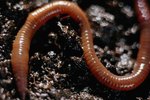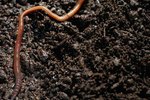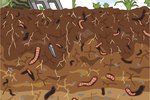
Earthworms were once found only in Europe, but they now thrive across the North American and Asian continents as well. While it may seem that one worm is as good as another for fishing and gardening, the term "earthworm" actually describes thousands of unique species that fill various ecological roles.
Anecic Earthworms
The term "anecic" means "up from the earth" in ancient Greek. Worms in this category tend to make vertical tunnels into the ground, but their primary food source is decaying matter on top of the soil. You can often identify a burrow made by an anecic earthworm thanks to the characteristic mounds of dirt, known as "middens," that surround most tunnel entrances, according to Maharani's Science College Bioinformatics Infrastructure Facility. The nightcrawler (Lumbricus terrestris) is one of many earthworm species classified as anecic.
Endogeic Earthworms
Endogeic means "within the earth" in Greek. The name is certainly appropriate, since the only time worms of this type come to the soil's surface is when excess rain puts them at risk of drowning in their tunnels, according to Colorado State University Extension. They build sprawling burrows underground, although the structures are usually only temporary. Their diet consists of organic material that's already beneath and mixed with the soil. They are a key component of various ecosystems and agricultural enterprises because they process and enrich soil as they eat. Green worm (Allolobophora chlorotica) is an endogeic species commonly found throughout the United Kingdom.
Epigeic Earthworms
Epigeic is Greek for "upon the earth." Earthworms in this category don't construct permanent burrows underground. Instead they spend most of their life above the surface, according to Colorado State University Extension. Like anecic worms, these also survive on a diet of decaying and dead organic matter scattered across the ground. Compost worms and manure worms are both members of this category. Epigeic earthworms have close symbiotic relationships with internal microorganisms that help them process large amounts of waste material.
Earthworm Identification
While you might be able to figure out the category your earthworm belongs to, you'll need more information before determining the exact species. Measure the worm at full length with a ruler and note its color and any markings or patterns on the body. Jot down a few notes about the earthworm's burrowing behaviors if you noticed any. Consult a reference book or online resource like the NatureWatch online key to identify the worm based on your observations. NatureWatch's key allows you to select one of several options through a series of slides to identify an earthworm you've found.
References
Resources
Photo Credits
-
Ryan McVay/Photodisc/Getty Images
Writer Bio
Quentin Coleman has written for various publications, including All Pet News and Safe to Work Australia. He spent more tan 10 years nursing kittens, treating sick animals and domesticating semi-feral cats for a local animal shelter. He graduated from the University of Delaware with a bachelor's degree in journalism.




